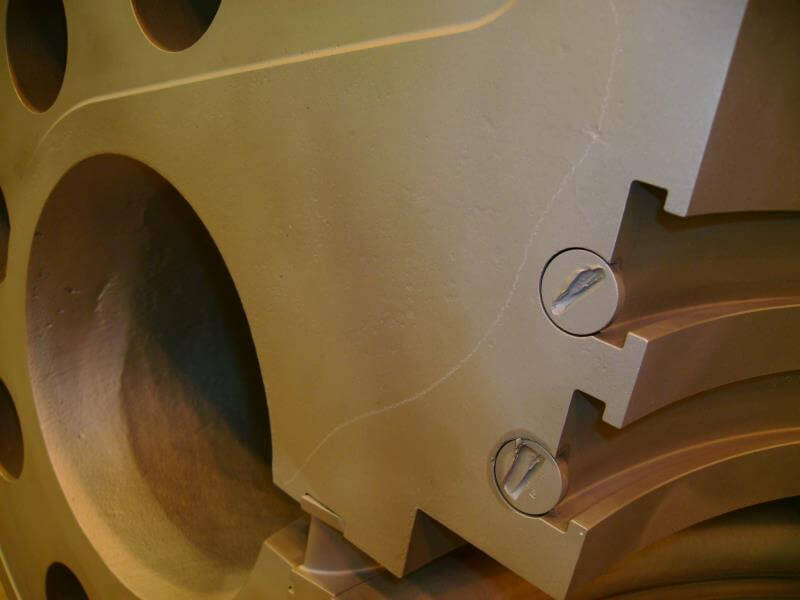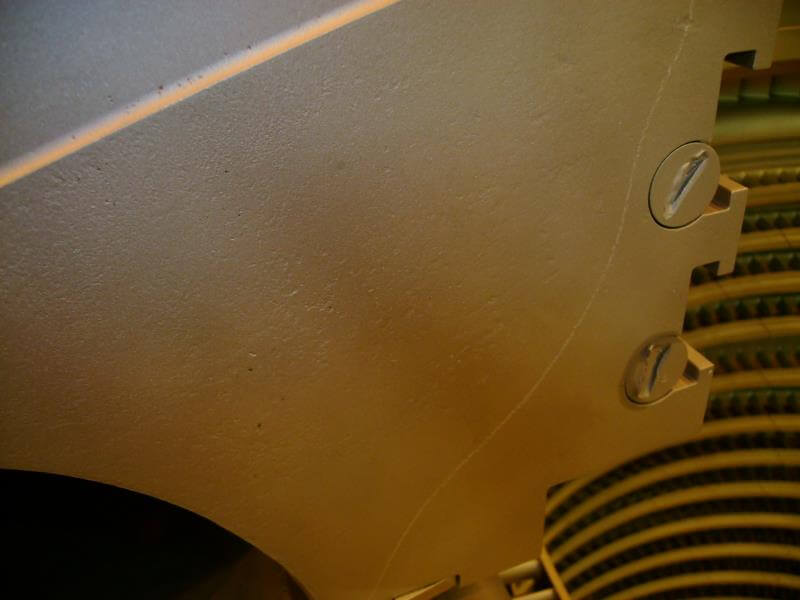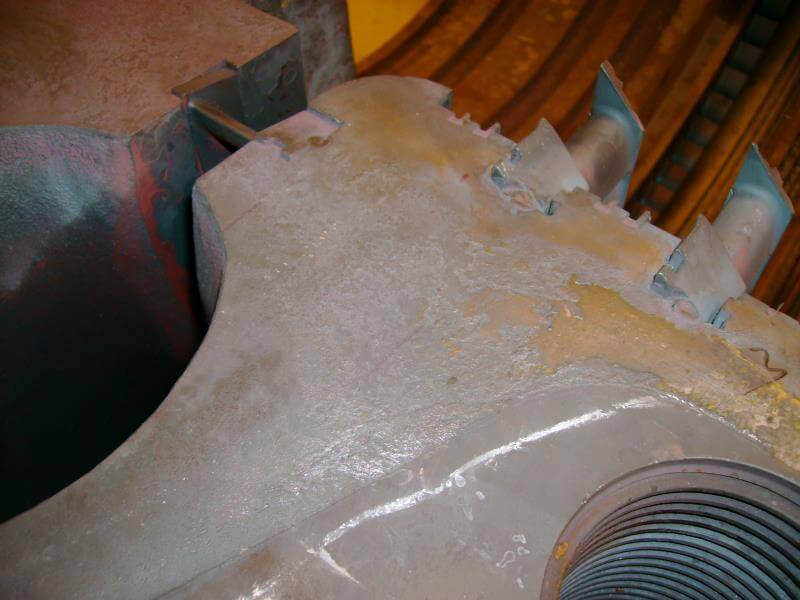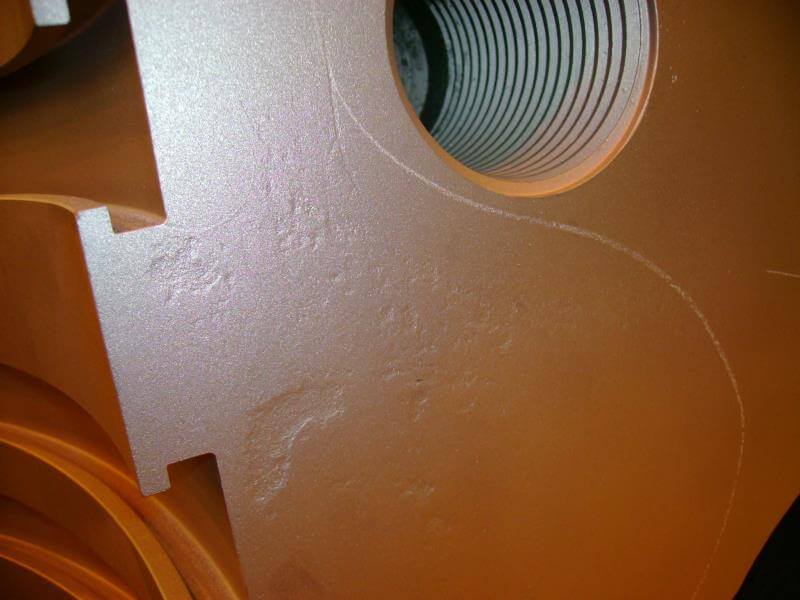Machining guidelines
| Name | Dieter Bartkowiak |
|---|---|
| Dept. | Engineering Dept AIS 2 |
| Tel. | +49 3581 75005-10 |
| Fax | +49 3581 75005-20 |
| management@a-i-schulze.com | |
| Our ref. | 001/13 Customers |
| Your supplier no. | S101 |
| Date | 02.05.2013 |
| In use since | 02.05.2013 |
Machining guidelines for sealing turbines and turbosets of our customers using the BIRKOSIT Dichtungskitt® product
On the following turbine types
- Steam turbines
- Gas turbines
and - Turbosets
Type High-Pressure Turbine (HPT)
- The butt joints in high-pressure turbines comprise two sealing strips with a continuous sealing surface
- There is one inner and one outer sealing strip
- Only the inner sealing strip is load-bearing (Internal strip)
Type Medium-Pressure Turbine (MPT), Low-Pressure Turbine (LPT)
- The butt joints in medium-pressure turbines (MPT) and low-pressure turbines (LPT) comprise one continuous sealing surface with centered cylindrical holes
- The inner sealing area of the butt joints is load-bearing as standard up to the commencement of the cylinder bores
If the requirements of points 1 to 4 in the general machining guidelines are satisfied we will guarantee
- 100% sealing of the turbine surfaces (butt joints) with the temperature and pressure data according to our product literature on
- Steam turbines
- Gas turbines
- Turbosets
Görlitz, 01.05.2013
A.I. Schulze Chemotechnische Fabrik e.K.
Company Management
Dieter Bartkowiak
General information to comply with the machining guidelines for sealing butt joints with the BIRKOSIT Dichtungskitt® product on steam turbines, gas turbines and turbine sets.
1. Product properties of the BIRKOSIT Dichtungskitt® material for sealing butt joints on steam turbines, gas turbines and turbine sets
- BIRKOSIT Dichtungskitt®is a single-component, paste luting agent/sealing material for industrial use wherever conditions of temperature combined with pressure on smooth, plane sealing surfaces (butt joints) make extreme demands on the quality of the to the sealing compound. This applies, in particular, to the sealing of metallic joints in:
steam and gas turbines, compressors, generators, expanders, pumps, flange joints, etc. - BIRKOSIT Dichtungskitt® withstands hot steam and air, hot and cold water, light fuel oils and lubricants, as well as crude oil and natural gas at temperatures of up to 900 °C.
- The adhesion on sealing surfaces and butt joints is so high that a one hundred percent seal is guaranteed even for pressures up to 250 bar. The pressure resistance for flanges without sealing rings is guaranteed up to 450 bar, and even up to 550 bar for screw joints.
- When used in accordance with instructions and with regular servicing as required for steam and gas turbines as well as for the application areas stated above, we guarantee a service life for use on machined sealing surfaces (butt joints)
of 10 years. - BIRKOSIT Dichtungskitt®is suitable for sealing all surface sizes. The surface quality of the sealing surfaces complies with milled/scraped surfaces with a finishing accuracy of Ra = 0.8 µm to 1.2 µm. Sealing surface damage of ≤ 0.2 mm is compensated with BIRKOSIT Dichtungskitt®.
- BIRKOSIT Dichtungskitt® has the water- endangering class WK1 (slightly hazardous to water) and is thereforeclassified as non-hazardous materail.
2. Preconditions for carrying out an operational test upon sealing butt joints with the BIRKOSIT Dichtungskitt® product on steam turbines, gas turbines and turbo sets
- In order to test the sealing properties of BIRKOSIT Dichtungskitt® an operational test with the elements steam, temperature and pressure is to be preformed. In the case of an operational test which is carried out solely with the elements water and pressure, the sealing compound is unable to interlink permanently with the surface irregularities on the sealing surfaces on the butt joints , and thus seal these permanently. The material would be washed out from the butt joints. The temperature element is absolutely vital. In combination with the pressure element it leads to the material becoming adhesive. It remains elastic and seals the surfaces of the areas to be sealed on the butt joints permanently.
- Additional possibilities of the operational test upon BIRKOSIT Dichtungskitt® arise at steam pipes or flange joints, on which steam temperature and pressure impinge.
- In general the operational test may be performed on any kind of metallic joint, upon which the combination of high temperature and pressure prevails .
3. Definitions and complying with the guidelines for sealing the butt joints with the BIRKOSIT Dichtungskitt® on steam turbines, gas turbines and turbine sets
Type: high-pressure turbines (HPT), medium-pressure turbines (MPT) and low-pressure turbines (LPT)
- Constructional design of the sealing surfaces at the butt joints
- The butt joints comprise two sealing strips with a continuous sealing surface. There is one inner and one outer sealing strip. The inner sealing strip is load bearing (internal strip).
- The butt joints in medium-pressure turbines (MPT) and low-pressure turbines (LPT) comprise one continuous sealing surface with centered cylindrical holes
Required surface condition of the sealing surfaces on the butt joints in style (HPT)
The sealing areas of the butt joints on high-pressure turbines (HPT) comprise one inner sealing strip and one outer sealing strip.
The inner strip (internal strip) is the load-bearing, sealing strip.
- The load-bearing sealing surface at the butt joints on high-pressure turbines (HPT) is the inner strip (internal strip). This must be load-bearing throughout. The surface quality of the sealing areas of the internal strip complies with milled surfaces and/or trimmed surfaces having a accuracy Ra = 0.8 µm to 1.2 µm. The limiting values for the Ra value are Ra = 30 µm to 50 µm, in order to seal off the butt joints.
- When there is damage to the butt joint sealing surface of ≥ 0.3 mm to 0.5 mm both turbine halves are as a rule exchanged with one another in order to identify erosion/corrosion damage and these are compensated for by mechanical machining. This means that the inner strips of the upper and lower turbine halves are mechanically machined against one another and hance compensate for the damage and unevenness of the sealing surfaces.
The outer strip (external strip) is not the load-bearing, sealing strip.
- The surface quality of the sealing areas of the outer strip complies with milled surfaces and/or trimmed surfaces having a finishing accuracy of about 0.1 mm. The outer strip can have and indeed must have a larger clearance; thus a greater tightening torque can be transmitted to the inner strip when screwing the upper to the lower turbine half using the heating screws, via which the turbine halves are sealed.
Required surface condition of the sealing surfaces on the butt joints in styles MPT and LPT
The sealing areas of the butt joints on medium-pressure turbines (MPT) and low-pressure turbines (LPT) comprise a continuous sealing surface with centered cylindrical holes.
- The load-bearing and sealing surface area at the butt joints on medium-pressure turbines (MPT) and low-pressure turbines (LPT) is the inner sealing surface area as standard up to the commencement of the cylindrical holes. This must be load-bearing throughout. The surface quality of the the sealing areas of the inner strip complies with milled surfaces and/or trimmed surfaces having a finishing accuracy of Ra = 0.8 µm to 1.2 µm. The limiting values for the Ra value are Ra = 30 µm to 50 µm, in order to seal off the butt joints.
- When there is damage to the butt joint sealing surface of ≥ 0.3 mm to 0.5 mm both turbine halves are as a rule exchanged with one another in order to identify erosion/corrosion damage and these are compensated for by mechanical machining. This means that the inner strips of the upper and lower turbine halves are mechanically machined against one another and hence compensate for the damage and unevenness of the sealing surfaces.
The outer sealing surface area is a non load-bearing, sealing area.
- The surface quality of the outer sealing surface area complies with milled surfaces having a finishing accuracy of about 0.05 mm to 0.1 mm. The outer strip can have and indeed must have a larger clearance; thus a greater tightening torque can be transmitted to the inner strip when screwing the upper to the lower turbine half using the heating screws, via which the turbine halves are sealed.
Illustration of the required surface quality on steam turbines, gas turbines and turbine sets


Illustration of erosion/corrosion damage on steam turbines, gas turbines and turbine sets


4. Complying with the processing guidelines for sealing the finished processed butt joints with the BIRKOSIT Dichtungskitt® product on steam turbines, gas turbines and turbo sets
Type: high-pressure turbines (HPT), medium-pressure turbines (MPT) and low-pressure turbines (LPT)
BIRKOSIT Dichtungskitt® is suitable for sealing all surface sizes.
- Sealing surface damage of ≤ 0.2 mm is compensated with
BIRKOSIT Dichtungskitt®. - For spot repairs on badly damaged areas of ≥ 0.2 mm to 1.0 mm, we recommend the products FILLING basic®, FILLING 1000® und FILLING 2000®.
As a result, cost-intensive and possible mechanical rectification is no longer necessary. This applies, in particular especially also in the cross joint areas.
Step 1: Grind the load-bearing, sealing seal areas of the butt joints
- This step may only be carried out by highly qualified specialists. In order to guarantee an optimally primed surface for the sealing compound
BIRKOSIT Dichtungskitt® the sealing areas are lightly ground by means of an orbital sander with a cupped washer, grain size 60 – 80, fine. (Not necessary depending upon finishing accuracy).
Alternatively- The surfaces are to be trimmed.
Step 2: Clean the load-bearing, sealing seal areas of the butt joints
- The upper and lower butt joint of the HPT, MPT and LPT turbines are to be degreased and cleaned with a dry cloth.
Step 3: Application of BIRKOSIT Dichtungskitt® onto the load-bearing, sealing seal areas on the butt joints
- Apply the BIRKOSIT Dichtungskitt® to the dry sealing surfaces with a brush or putty knife on both sides. The layer thickness to be applied is 0.2 mm to 0.3 mm.
The product can be subjected to workloads immediately! It does not cure, will not change its consistency even after several hours, and remains flexible and elastic. It is therefore also suitable for butt joint machining. The colour is reddish brown. Heating the tin to room temperature or adding a tenth part of standard linseed oil varnish (AIS B020) from our product range will improve the brushability.
Step 4: Seal the high-pressure turbines (HPT), medium-pressure turbines (MPT), low-pressure turbines (LPT)
- The turbine halves are to be sealed in accordance with the manufacturer’s factory specifications.
The turbine may be started under load immediately without waiting time!
